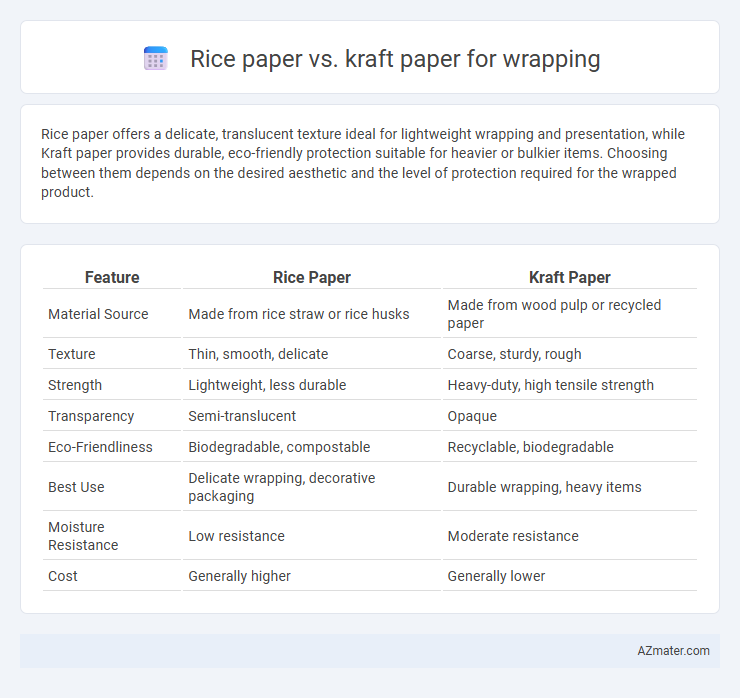Rice paper offers a delicate, translucent texture ideal for lightweight wrapping and presentation, while Kraft paper provides durable, eco-friendly protection suitable for heavier or bulkier items. Choosing between them depends on the desired aesthetic and the level of protection required for the wrapped product.
Table of Comparison
| Feature | Rice Paper | Kraft Paper |
|---|---|---|
| Material Source | Made from rice straw or rice husks | Made from wood pulp or recycled paper |
| Texture | Thin, smooth, delicate | Coarse, sturdy, rough |
| Strength | Lightweight, less durable | Heavy-duty, high tensile strength |
| Transparency | Semi-translucent | Opaque |
| Eco-Friendliness | Biodegradable, compostable | Recyclable, biodegradable |
| Best Use | Delicate wrapping, decorative packaging | Durable wrapping, heavy items |
| Moisture Resistance | Low resistance | Moderate resistance |
| Cost | Generally higher | Generally lower |
Introduction: Comparing Rice Paper and Kraft Paper for Wrapping
Rice paper and Kraft paper serve distinct purposes in wrapping, each offering unique textures and durability levels. Rice paper, known for its thin, translucent quality, excels in delicate presentation and is often used in gourmet food packaging. Kraft paper provides a sturdy, eco-friendly option with a natural brown hue, favored for heavier wrapping needs and robust protection.
Overview of Rice Paper Wrapping
Rice paper wrapping provides a lightweight, translucent, and biodegradable option favored for delicate food presentation and artistic packaging. Its smooth texture and natural fibers allow for excellent breathability and moisture resistance, making it ideal for wrapping fresh produce, sushi, and gift items. Rice paper's eco-friendly properties and elegant appearance have made it a popular alternative to Kraft paper in sustainable packaging solutions.
Overview of Kraft Paper Wrapping
Kraft paper wrapping is renowned for its durability and eco-friendly properties, being made from natural wood fibers without harmful chemicals. Its high tear resistance and moisture permeability make it ideal for protecting delicate items during shipping. This versatile wrapping material also offers a rustic aesthetic that appeals to sustainable packaging trends.
Material Composition: Rice Paper vs Kraft Paper
Rice paper is made from natural fibers such as rice straw, hemp, or mulberry bark, resulting in a thin, translucent texture that is delicate yet eco-friendly. Kraft paper is produced from wood pulp through the kraft process, yielding a sturdy, coarse material known for its durability and tensile strength. The organic composition of rice paper makes it ideal for lightweight, biodegradable wrapping, whereas the lignin-rich kraft paper offers robust protection and resistance to tearing in packaging applications.
Strength and Durability: Which Paper Wraps Better?
Rice paper offers delicate texture and moderate strength, suitable for lightweight wrapping but prone to tearing under heavy stress. Kraft paper, known for its robust fibers and high tensile strength, provides superior durability and resistance to ripping, making it ideal for securely wrapping heavier or bulkier items. For applications requiring reliable protection and long-lasting support, kraft paper outperforms rice paper in strength and durability.
Environmental Impact and Sustainability
Rice paper is biodegradable and compostable, made from natural starches, which reduces environmental pollution and supports sustainable wrapping practices. Kraft paper, derived from wood pulp using a chemical kraft process, is recyclable and often sourced from sustainably managed forests, contributing to reduced deforestation. Both materials offer eco-friendly alternatives to plastic wrap, but rice paper typically has a lower carbon footprint due to its plant-based, renewable origin and minimal processing requirements.
Aesthetic Appeal and Customization Options
Rice paper offers a delicate, translucent aesthetic that enhances the visual appeal of wrapped items with its smooth texture and subtle sheen, ideal for gourmet or artisanal products. Kraft paper provides a rustic, natural look with a sturdy feel, making it perfect for eco-friendly branding and customizable with stamps, inks, or embossing to suit various design preferences. Both materials support customization, but rice paper excels in creating elegant, refined presentations while kraft paper emphasizes earthy, robust packaging styles.
Food Safety and Suitability for Edible Uses
Rice paper is highly suitable for edible uses due to its natural, food-grade composition and biodegradability, making it a safe choice for direct contact with food items such as spring rolls and edible decorations. Kraft paper, while strong and eco-friendly, is generally not recommended for direct food contact unless it is specially coated or treated to meet food safety standards, as untreated kraft paper may contain inks, adhesives, or contaminants harmful to health. When prioritizing food safety and suitability for edible wrapping, rice paper offers a more reliable and hygienic option, especially for applications requiring direct consumption or intimate contact with food.
Cost Comparison and Accessibility
Rice paper typically costs more than kraft paper due to its delicate processing and specialty use in wrapping, making it less budget-friendly for large-scale or everyday packaging. Kraft paper is widely accessible, produced in large quantities from recycled materials, and favored for its durability and low price, often costing significantly less per square foot than rice paper. Businesses prioritizing cost efficiency and easy supply sourcing generally prefer kraft paper, while rice paper is reserved for premium or artisanal wrapping applications.
Conclusion: Choosing Between Rice Paper and Kraft Paper for Wrapping
Rice paper offers a delicate, translucent aesthetic ideal for lightweight, decorative wrapping, while kraft paper provides robust durability and superior protection for heavier items. Selecting between rice paper and kraft paper depends primarily on the desired appearance and the level of strength required for the wrapped product. For environmentally conscious packaging, both materials are eco-friendly options, but kraft paper's higher tear resistance often makes it preferable for secure, long-lasting wraps.

Infographic: Rice paper vs Kraft paper for Wrapping
 azmater.com
azmater.com